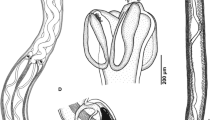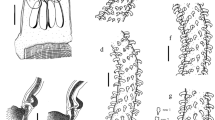Abstract
Based on a light- and scanning electron microscopical study of scolex morphology, tentacles and surface structures of 31 trypanorhynch species, an alternative classification of the trypanorhynch cestodes, adults, plerocerci and postlarvae, is presented. The arrangement of the tentacular armature is no longer used as a distinguishing feature for four different superfamilies. Instead, the presence or absence of ciliated pits and prebulbular organs is used to define three superfamilies: Tentacularioidea Poche, 1926; Otobothrioidea Dollfus, 1942; and Eutetrarhynchoidea Guiart, 1927. A total of 12 families are defined by the characters: the presence/absence of blastocysts, the number of bothridia and the reduction of the rhyncheal apparatus, together with a new character, complete rows of tentacular hooks (homeoacanth and heteroacanth typica) versus rows of hooks partly reduced (heteroacanth atypica and poeciloacanth). Of the 19 families previously accepted, 10 are retained (Eutetrarhynchidae, Gilquiniidae, Lacistorhynchidae, Mixodigmatidae, Otobothriidae, Paranybeliniidae, Pterobothriidae, Shirleyrhynchidae, Sphyriocephalidae and Tentaculariidae, all sensu nov.); one family is reinstated (i.e. Aporhynchidae Poche, 1926 sensu nov.) and a new one is added (i.e. Pseudotobothriidae n. fam.). Advantages of this alternative classification of trypanorhynch cestodes are: (i) the resolution of incongruities and questions caused by the use of the tentacular armature to distinguish superfamilies; (ii) the criteria for the establishment of higher taxa, superfamilies and families are clearly defined; (iii) with the findings of new species with different character combinations, this system can be enlarged up to 4 superfamilies and 48 families without loosing its stability; and (iv) all existing genera are easily re-assigned to the superfamilies and families.
Similar content being viewed by others
References
Beveridge, I. & Campbell, R.A. (1988) A review of the Tetrarhynchobothriidae Dollfus, 1969 (Cestoda: Trypanorhyncha) with descriptions of two new genera, Didymorhynchus and Zygorhynchus. Systematic Parasitology, 12, 3–29.
Beveridge, I. & Campbell, R.A. (1989) Chimaerarhynchus n. g. and Patellobothrium n. g., two new genera of trypanorhynch cestodes with unique poeciloacanthous armatures, and a reorganisation of the poeciloacanthous trypanorhynch families. Systematic Parasitology, 14, 209–225.
Campbell, R.A. & Beveridge, I. (1994) Order Trypanorhyncha Diesing, 1863. In: Khalil, L.F., Jones, A. & Bray, R.A. (Eds). Keys to the cestode parasites of vertebrates. Wallingford: CAB International, pp. 50–148.
Campbell, R.A. & Beveridge, I. (1996) Revision of the family Pterobothriidae Pintner, 1931 (Cestoda: Trypanorhyncha). Invertebrate Taxonomy, 10, 617–662.
Carvajal, J. & Campbell, R.A. (1975) Rhinoptericola megacantha gen. et sp. n., representing a new family of trypanorhynch cestodes from the cownose ray, Rhinoptera bonasus (Mitchill 1815). The Journal of Parasitology, 61, 1,023–1,030.
Dailey, M.D. & Vogelbein, W. (1982) Mixodigmatidae, a new family of cestode (Trypanorhyncha) from a deep sea, planktivorous shark. The Journal of Parasitology, 68, 145–149.
Deardorff, T., Raybourne, R.B. & Mattis, T.E. (1984) Infections with trypanorhynch plerocerci (Cestoda) in Hawaiian fishes of commercial importance. Sea Grant Quarterly, 6, 1–6.
Dollfus, R.P. (1942) Études critiques sur les Tétrarhynques du Museum de Paris. Archives du Muséum National d'Histoire Naturelle, 19, 1–466.
Dollfus, R.P. (1969) De quelques Cestodes Tétrarhynques (Hétéracantes et Pécilacanthes) récoltés chez des poissons de la Méditerranée. Vie et Milieu, Série A, 20, 491–542.
Guiart, J. (1927) Classification des Tétrarhynques. Comptes rendus de la 50. Session de l'Association Francaise pour l'Avancement des Science, Lyon, 1926, pp. 397–401.
Kinne, O. (1990) Diseases of marine animals Vol. III. Hamburg: Biologische Anstalt Helgoland, 696 pp.
Linton, E. (1890) Notes on Entozoa of marine fishes of New England, with descriptions of several new species. Part II. Annual Report of the United States Commissioner of Fish and Fisheries for 1887, pp. 719–900; pl. I–XV.
Mattis, T.E. (1986) Development of two tetrarhynchidean cestodes from the northern Gulf of Mexico. Dissertation, University of Southern Mississippi, 171 pp.
Mayr, E. & Ashlock, P.D. (1991) Principles of systematic zoology. New York: McGraw-Hill, Inc., 475 pp.
Palm, H.W. (1995) Untersuchungen zur Systematik von Rüsselbandwürmern (Cestoda: Trypanorhyncha) aus atlantischen Fischen. Berichte aus dem Institut für Meereskunde Kiel, 275, 238 pp.
Pintner, T. (1880) Untersuchungen über den Bau des Bandwurmk örpers mit besonderer Berücksichtigung der Tetrabothrien und Tetrarhynchen. Arbeiten aus dem Zoologischen Institut der Universität Wien und der Zoologischen Station in Triest, 3, 163–242, pl. XIV–XVIII.
Richmond, C. & Caira, J.N. (1991) Morphological investigations into Floriceps minacanthus (Trypanorhyncha: Lacistorhynchidae) with analysis of the systematic utility of scolex microtriches. Systematic Parasitology, 19, 25–32.
Rodhouse, P.G. & Nigmatullin, Ch.M. (1996) Role as consumers. Philosophical Transactions of the Royal Society of London, Series B, 351, 1,003–1,022.
Schmidt, G.D. (1986) Handbook of tapeworm identification. Boca Raton: CRC Press Inc., 675 pp.
Wardle, R.A. & McLeod, L.A. (1952) The zoology of tapeworms. Minneapolis: University of Minnesota Press, 780 pp.
Author information
Authors and Affiliations
Rights and permissions
About this article
Cite this article
Palm, H.W. An alternative classification of trypanorhynch cestodes considering the tentacular armature as being of limited importance. Syst Parasitol 37, 81–92 (1997). https://doi.org/10.1023/A:1005765126294
Issue Date:
DOI: https://doi.org/10.1023/A:1005765126294




